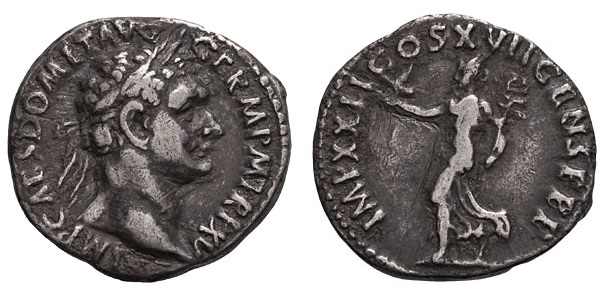
Domitian
AR Denarius, 3.06g
Rome Mint, 95-96 AD
Obv: IMP CAES DOMIT AVG GERM P M TR P XV; Head of Domitian, laureate, bearded, r.
Rev: IMP XXII COS XVII CENS P P P; Maia adv. l., with dove and caduceus
RIC 786 (R2). BMC 237A. RSC 295. BNC -.
Ex Gemini XI, 12 January 2014, lot 418. Ex C. Clay Collection. Ex Voirol Collection, M&M 38, 6-7 December 1968, lot 403. Ex M&M VI, 6-7 December 1946, lot 804. This specimen published by H. A. Cahn, ‘Flaviana indedita’, Num. Chronicle 1946 p. 22, 50.
A “Strange and uncertain reverse” is how this type for many years was described by the major reference catalogues. It is so rare that its very existence was in doubt. Eventually, other examples surfaced (including this coin in 1946) establishing there was indeed a “strange” type struck by Domitian towards the end of his reign. A woman with bird was the normal description until 2002 when T. V. Buttrey published in the Journal of Roman Archaeology a short paper establishing once and for all who the woman is and possibly why the type was struck. He identified her as Maia, the mother of Hermes/Mercury, wearing a winged helmet and possibly winged sandals. Maia is to be identified with “natural growth and commercial success” according to Buttrey. He further writes “For the precious metals, the constant themes were Domitian’s offices, his military successes, his piety (in particular his relationship with Minerva), and the divine grace which infused his life, and by extension, that of the community. It is in this context that Maia should be understood, the coin illustrating the emperor’s acknowledgement of the goddess’s abundant favor.”
Needless to say the type is fantastically rare, with perhaps a dozen known examples from only two reverse dies. The reverse die shown here (with my obverse dated TR P XV) is also shared with an obverse die dated TR P XVI, placing this coin in the very last weeks of Domitian’s reign. During this time Domitian was introducing many new reverse types (winged Minerva, altar, temple reverses), perhaps indicating a change in direction regarding the typology on his precious metal coinage. However, the experiment was cut short by an assassin’s blade, so we shall never know.
